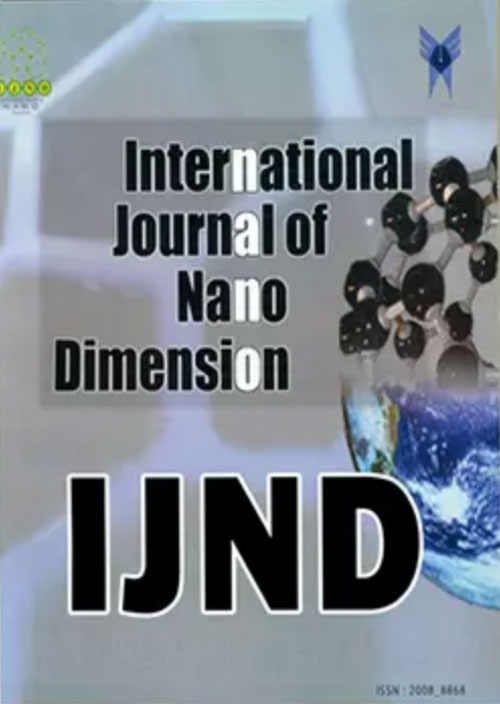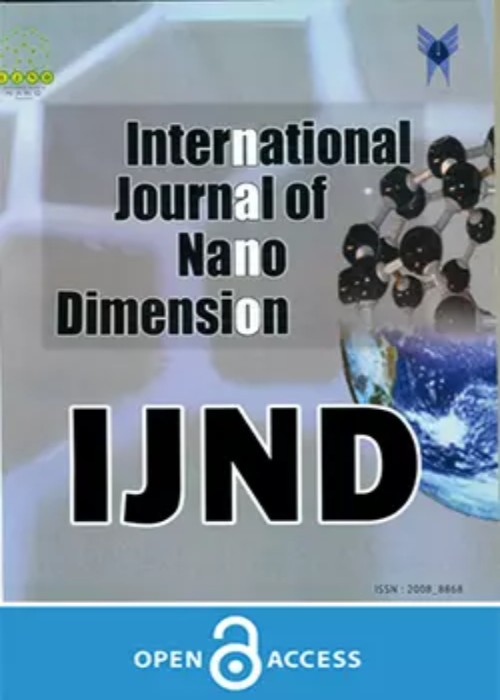فهرست مطالب

International Journal of Nano Dimension
Volume:13 Issue: 4, Autumn 2022
- تاریخ انتشار: 1401/07/26
- تعداد عناوین: 8
-
-
Pages 344-352This paper focuses on the performance of introducing zeolite nanocomposite into photoanodes of dye-sensitized solar cells. Mesoporous titanium dioxide and zeolite nanoparticles were synthesized using hydrothermal technique. The Synthesized nanocomposite was characterized by various techniques via X-ray diffraction technique, Scanning electron microscopy, and Ultraviolet visible spectrophotometer. XRD analysis showed highly crystalline zeolite, Titanium oxide and its composite showed polycrystalline nature. SEM results elucidated that the incorporation of Titanium oxide into zeolite changed the surface morphology from rectangular to spherical. Ultraviolet visible spectroscopy shows that the bandgap of zeolite, titanium oxide, and its composite is 3.4, 3.2, and 4.14 eV, respectively. Current voltage results confirmed the formation of p-n heterojunction formed between p– and n-type materials indicating the behavior of solar cell devices.Keywords: Composite, SEM, Synthesis, Titanium Oxide, zeolite
-
Pages 353-361Quantum-dot cellular automata technology has emerged as an alternative for complementary metal oxide semiconductor technology in very-large-scale integration (VLSI) circuits. The basis and structure of QCA technology are different from CMOS technology, and it is necessary to redesign the existing circuits based on the characteristics of QCA technology. In this paper, first, five-input and three-input majority gates are proposed with the ability to work in the one-dimensional clock. Then a full adder based on the proposed majority gates in the one-dimensional clock was designed with 0.75 clock cycle latency. As a consequence of the location of the circuit’s inputs & outputs, this full adder can easily be converted to a multi-bit adder. This paper introduces a four-bit adder utilizing the same method, endeavoring to design the circuit compliant with the inherent features of QCA technology and prove that the proposed circuit can be constructed. For design as well as manufacturing process simplicity, a general framework for design (in one-dimensional clock) is also hereby proposed. Proposed designs are confirmed by QCADesigner, a well-known QCA layout design and verification tool, and QCADesigner-E for power analysis.Keywords: Five-Input Majority Gate, Full adder, Majority, QCA, QCADesigner E, RCA Adder, 1-d Clocking, 4-bit adder
-
Pages 362-373Bioactive glass is an appropriate substance for the transporting a pharmaceutical compound owing to its special effects (containing great antibacterial, semiconducting, nanoporous, adherent, and strong bonding with the bone tissue). Hence, in recent years, many investigations have been done in this topic. However, several constraints alike fast drug release and slow drug loading ability are observed in preceding researches. The researchers proposed that restrictions can be resolved by improving the fabricating method of bioglass and the reinforcement of diverse nanocomposites for postponing drug release. Therefore, new bioglass/maltdextrin nanocomposites were created via the sol-gel procedure in the absence and presence of Polyvinylpyrrolidone (PVP) as an organic modifier. bioglass/maltdextrin nanoparticles and bioglass/maltdextrin/PVP nanocomposites were characterized by (XRD) technique, (EDX), (FE-SEM) and (FT-IR). Moreover, the loading of flutamide and release behavior at pH = 7.4 and T = 37 °C of the provided specimens were determined by UV-Vis Spectroscopy. The effects of flutamide Loading on the bioglass/maltdextrin/PVP nanocomposites at different times (6, 8, 24 and 72 hrs.) were investigated. Also, the structural properties of bioglass / maltodextrin / PVP nanocomposites on loading and release of flutamide were evaluated. The capability of nanocomposites for flutamide delivery was surveyed as a drug delivery pattern under in vitro condition. Percentage of Drug loading efficiency on nanocarriers 99.89% was acquired, and eventually the release rate was reduced slowly up to nearly 12 days. Accordingly, the outcomes ascertained that the bioglass/maltdextrin/PVP nanocomposites with the high loading performance and stable release ability can be appropriate candidates for sustained flutamide release.Keywords: Efficiency, nanoparticles, prostate cancer, Release, sol-gel
-
Pages 374-386Nitrate is one of the major environmental problems in today’s world, which affect human health and welfare, and hinders the sustainable development of both society and the economy. Therefore, the growth of sensor based on decorated noble metal nanoparticles (NPs) such as Ag have been attracted great attention for their convenience of simple operation, excellent absorption and scattering (extinction) properties in recent years. A new and simple fluorometric sensing probe based on polyaniline functionalized AgNPs for NO3- ion detection was developed by polymerization method. It has been successfully synthesized by in- situ polymerization method. The structural, morphological and optical properties of the as-synthesized nanocomposites were characterized by using, fourier- transform infrared spectroscopy (FT-IR), powder X-ray diffraction (XRD), scanning electron microscopy (SEM) and UV-Vis spectroscopy. In the absence of nitrate ion, the PANI/Ag exhibit high fluorescence intensity. Yet, the strong coordination of the basic sites with nitrate ion causes fluorescence intensities quenching through static quenching leading to the qualitative and quantitative detection of nitrate ion. Factor affecting the detection system such as pH and concentration are optimized. Also, the developed PANI modified Ag sensor exhibits high selectivity and sensitive toward nitrate ion with detection limit of 8.9×10-4 M. The practical use of the sensor as well tested by spiked with different concentration of nitrate ion solutions on cabbage samples. The result signposted a good linear relation between FO/F and the spiked concentrations of nitrate ion with coefficient of regression R2 = 0.991 (n= 3) and also confirms that the found values is agreed well with the spiked amount.Keywords: fluorescent, nanocomposite, Nitrate Ion, Polyaniline, Quenching, sensor, Toxicity
-
Pages 387-396In this present work, MWCNTs modified NiFe2O4 NPs (M-MWCNT) were successfully fabricated based on a hydrothermal route, and then utilized to Pb(II) sorption from an aqueous solution. The M-MWCNT was characterized and analyzed by SEM, TEM, FTIR, XRD, and VSM techniques. TEM image demonstrated that the size of NiFe2O4 nanoparticles in the structure of MWCNT was 20 nm. VSM results indicated that the M-MWCNT with saturation magnetization (Ms) value of 7 emu/g would have a fast magnetic response. According to X-ray data the average crystal sizes of the pure NiFe2O4 and M-MWCNT are 21.62 and 7.25 nm, respectively. The sorption kinetics, isotherms, thermodynamic and regeneration performance for lead ((Pb(II)) ions were evaluated. The M-MWCNT can effectively remove Pb(II) from aqueous solution at optimum pH of 5.5. Based on the Langmuir model, the maximum saturated adsorbed amount (qmax) of Pb(II) was up to 85.12 mg/g. The kinetic characteristic was appropriate for pseudo 1st order model expression, and the isothermal characteristic can be described via Longmuir model. The data obtained from the thermodynamic study show that the Pb(II) sorption using M-MWCNT nanocomposite was a spontaneous, exothermic and physisorption process with a good regeneration performance.Keywords: NiFe2O4NPs, nanocomposite, MWCNT, Lead (II) sorption, qmax
-
Pages 397-402In this paper, we present a new self-switching diode (SSD) realized with a two-dimensional semiconductor hexagonal boron carbon-nitrogen (hBCN) monolayer. Channel length and width are 4.5 nm and 1.23 nm respectively. The device operation is simulated based on the Extended Huckel method and Nonequilibrium Green’s Function (NEGF) Formalism. The simulation results indicate non-linear I-V characteristics of the nano-diode and a current rectification ratio near 11250 that is higher than previous SSD structures reported before. Also, the effects of channel width on the electrical characteristics of SSDs are investigated. It can be found that the bandgap value of hBCN plays an important role in the modulation of current in the channel. Transmission pathways are provided under reverse and forward biases to show channel opening and pinch-off conditions. The results indicate that hBCN is a promising material for the realization of self-switching diodes (SSDs).Keywords: Extended Huckel Method, Nanoscale Self Switching Diode, NEGF, Rectification Ratio, Transmission Pathways
-
Pages 403-413Semiconductor nanoparticles have attracted a major role in several new technologies. The synthesis and study of nanostructured materials have become a major interdisciplinary area of research. Gadolinium (CH3 COO)2. 2H2O (Gd) at different concentrations doped ZnS nanoparticles synthesized by chemical precipitation method. The synthesised nanoparticles were investigated by XRD, SEM, EDAX, HRTEM and UV Visible spectral studies. The XRD result shows that Gadolinium doped ZnS nanoparticles exhibit a zinc blende (cubic) structure with uniform size distribution. The optimum concentration of doping Gd was determined as 3.5% from the XRD study. The EDAX spectrum confirmed the composition of the elements (Zn, Gd and S) in the sample. The Gd ion is in-corporated into the cubic Zinc blend phase of ZnS. The surface morphology of Gd doped ZnS nanoparticles was characterised by SEM. The HR TEM confirmed particle size as 20 nm. The optical band-gap energies of Gd doped ZnS nanoparticles increased as the concentration of Gd increased. The result obtained from the agar diffusion method displayed that the Gd doped ZnS nanoparticles have good antibacterial activity than undoped ZnS nanoparticles.Keywords: Band Gap Energies, Chemical precipitation, Optimum Concentrations, semiconductors, Surface Morphology, ZnS : Gd
-
Pages 414-434We herein report the green synthesis of a reduced Graphene Oxide/Silver nanoparticle (rGO/AgNP) nanocomposite by simultaneously reduction of graphene oxide and silver ions using an aqueous extract of cinnamon (Cinnamomum verum) plant bark. Methylene blue dye removal capacity and efficiency of the nanocomposite was evaluated. The synthesized nanocomposites were characterized by using UV‑DRS, SEM, P‑XRD, and FTIR spectroscopy. The XRD results showed the average particle sizes Ag NPs, rGO, and rGO/Ag NPs nanocomposite to 29.9 nm, 0.67 nm, and 13.35 nm respectively. The UV-DRS analysis result showed that rGO/Ag nanocomposite exhibited two absorbance peaks at 272 & 334 nm which corresponds to rGO and Ag NPs respectively. The FTIR spectral data revealed the functional groups characteristics of phytochemicals in the plant extract, rGO and rGO/AgNP nanocomposite. The surface morphology from SEM result obtained indicated that Ag NPs showed non-homogeneity and different shapes, rGO had thin flat layer sheet morphology whereas Ag NPs were deposited on rGO nanosheets in the form of clusters in the rGO/AgNP nanocomposite. The rGO/AgNP nanocomposite had highest methylene blue removal efficiency of 99.98% at optimum pH 2, adsorbent dose 80 mg, contact time 50 min and initial concentration of 10 mg/l. The Adsorption isotherms were well fitted to Langmuir isotherm for all synthesized adsorbents. The adsorption kinetics results were best fitted to the pseudo-second-order model. The green synthesized rGO/AgNP nanocomposite has the potential to be used as an adsorbent in wastewater treatment applications.Keywords: Adsorbent, Cinnamon Bark, Green synthesis, Methylene Blue, nanocomposite, rGO, AgNPs


